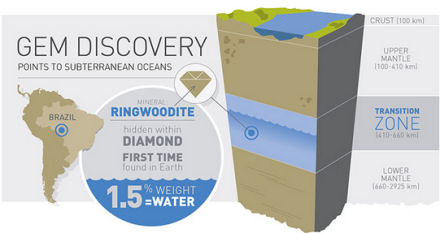
The chance discovery of a sample of a mineral called ringwoodite provides strong evidence for scientific theories about vast volumes of water trapped 410 to 660 kilometers (250 – 400 miles) beneath the surface of the Earth.
University of Alberta scientist Graham Pearson (pictured) said the discovery was almost accidental in that his team had been looking for another mineral when they purchased a three-millimeter-wide, dirty-looking, commercially worthless brown diamond. The ringwoodite itself was invisible to the naked eye, buried beneath the surface of the diamond. “It’s so small, this inclusion, it’s extremely difficult to find, never mind work on,” Pearson said, “so it was a bit of a piece of luck, this discovery.”
Ringwoodite is a form of the mineral peridot, believed to exist in large quantities under high pressures in the transition zone. Ringwoodite has been found in meteorites but, until now, no terrestrial sample has ever been unearthed because scientists haven’t been able to conduct fieldwork at extreme depths. Pearson said the diamond had been brought to the Earth’s surface by a volcanic rock known as kimberlite – the most deeply derived of all volcanic rocks.
The sample underwent rigorous testing using spectroscopy and X-ray diffraction before it was officially confirmed as ringwoodite. Analysis of the mineral showed it contains a significant amount of water – 1.5 per cent of its weight.

“This sample really provides extremely strong confirmation that there are local wet spots deep in the Earth in this area,” said Pearson, whose findings were published this week inNature. “That particular zone in the Earth, the transition zone, might have as much water as all the world’s oceans put together.”
Related:
Discuss this article in our forum
Deep oil reserves created without organic matter?
Under Pressure: Earth Science
Exotic Underground Bacteria Thrive On Radiation Rather Than Sunlight


















Comments are closed.